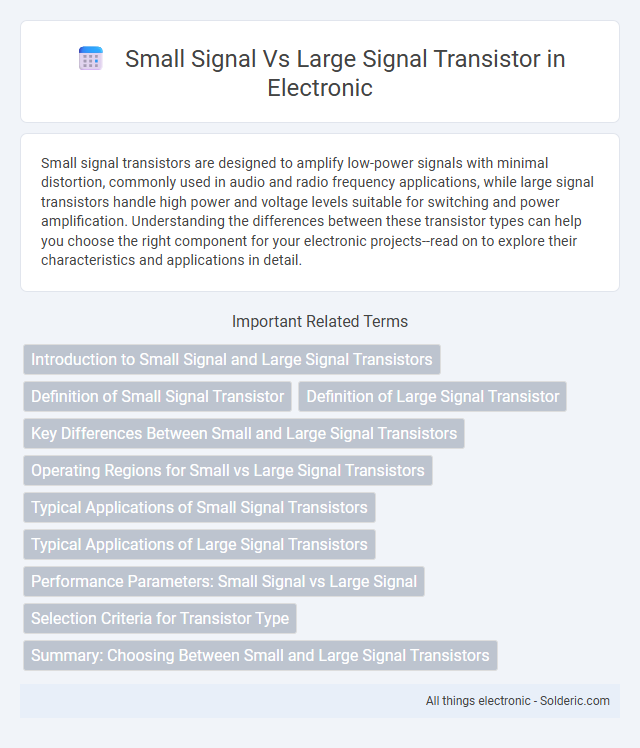Small signal transistors are designed to amplify low-power signals with minimal distortion, commonly used in audio and radio frequency applications, while large signal transistors handle high power and voltage levels suitable for switching and power amplification. Understanding the differences between these transistor types can help you choose the right component for your electronic projects--read on to explore their characteristics and applications in detail.
Comparison Table
| Aspect | Small Signal Transistor | Large Signal Transistor |
|---|---|---|
| Operating Region | Linear region, small input variations | Saturation or cutoff, large input variations |
| Signal Amplification | Amplifies low-level AC signals | Manages power, switches signals |
| Model Used | Small-signal equivalent model (h-parameters, hybrid-pi) | Large-signal model considering non-linearities |
| Purpose | Voltage/current gain for analog signals | Switching or power handling in digital/ power circuits |
| Input Signal Magnitude | Few millivolts to few volts | High voltage/current levels |
| Distortion | Minimal distortion, linear operation | Non-linear, may cause signal clipping |
| Examples | Audio amplifiers, RF amplifiers | Power regulators, digital switches |
Introduction to Small Signal and Large Signal Transistors
Small signal transistors operate within a linear region, handling low-frequency and low-amplitude signals ideal for amplification with minimal distortion. Large signal transistors manage higher power levels, switching applications, and large amplitude signals, often driving loads in digital circuits and power electronics. Understanding the distinction aids in selecting the appropriate transistor for specific electronic circuit requirements.
Definition of Small Signal Transistor
A small signal transistor operates within a linear region where the input signals are minute enough to cause proportionally small variations in the output current, allowing for accurate amplification without distortion. It is primarily used in analog circuits such as amplifiers and oscillators to handle low-level signals. Understanding small signal transistor behavior involves analyzing incremental changes around a bias point using parameters like transconductance and input resistance.
Definition of Large Signal Transistor
A large signal transistor is designed to operate with input signals that cause significant variations in output current or voltage, often driving the transistor into saturation or cutoff regions. Unlike small signal transistors, which handle minor signal fluctuations around an operating point, large signal transistors manage high power or high amplitude signals, making them essential in power amplification and switching applications. Your circuit's performance depends on choosing the right transistor type based on signal magnitude and application requirements.
Key Differences Between Small and Large Signal Transistors
Small signal transistors are designed to amplify low-power signals with minimal distortion, typically operating in the linear region and handling currents in the microampere to milliampere range. Large signal transistors, on the other hand, manage higher power levels, frequently switching or amplifying signals in the range of amperes, and are optimized for power amplification or switching applications. The main differences lie in their maximum current capacity, frequency response, and application focus, where small signal transistors prioritize high-frequency amplification and large signal transistors emphasize power handling and thermal stability.
Operating Regions for Small vs Large Signal Transistors
Small signal transistors typically operate in the active region, where the transistor acts as an amplifier with linear response to input signals. Large signal transistors function in saturation or cutoff regions for switching applications, handling higher currents and voltages with non-linear behavior. Understanding these operating regions is crucial for designing circuits optimized for amplification or switching performance.
Typical Applications of Small Signal Transistors
Small signal transistors are typically used in applications such as audio amplification, radio frequency (RF) circuits, and signal processing where low power and high-frequency operation are essential. These transistors excel in amplifying weak signals without significant distortion, making them ideal for preamplifiers and oscillator circuits. Your electronic devices rely on small signal transistors to ensure precise control and amplification of low-level input signals.
Typical Applications of Large Signal Transistors
Large signal transistors are primarily used in power amplification, switching applications, and voltage regulation due to their ability to handle high current and voltage levels efficiently. Common applications include audio power amplifiers, radio frequency transmitters, DC-DC converters, and motor control circuits where large power dissipation is required. These transistors are designed to operate in saturation and cutoff regions, making them ideal for robust performance in power electronics and industrial systems.
Performance Parameters: Small Signal vs Large Signal
Small signal transistors excel in high-frequency applications with low distortion, characterized by parameters like gain-bandwidth product, input and output impedance, and noise figure. Large signal transistors handle higher voltage and current levels, with performance parameters focused on power dissipation, saturation voltage, and switching speed. Your choice depends on whether precision amplification or power handling is crucial for your circuit design.
Selection Criteria for Transistor Type
Selection criteria for small signal versus large signal transistors depend primarily on the intended application and power handling requirements. Small signal transistors are ideal for low power amplification and switching where high frequency response and low noise are crucial, making them suitable for radios and signal processing. Large signal transistors, designed to handle higher currents and voltages, are preferred in power amplification and power regulation circuits, ensuring Your device manages power efficiently without thermal or electrical stress.
Summary: Choosing Between Small and Large Signal Transistors
Small signal transistors excel in low-power amplification and switching applications, handling signals typically in the milliwatt range with high frequency response and low noise. Large signal transistors are designed for high power and high voltage operations, making them suitable for power amplification and switching in applications such as motor drives and RF transmitters. Selecting between small and large signal transistors depends on the required power handling, frequency characteristics, and application-specific demands.
Small signal vs Large signal transistor Infographic

 solderic.com
solderic.com